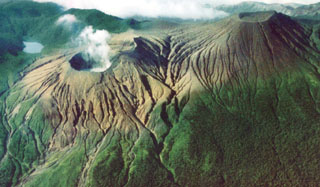Report on Rincon de la Vieja (Costa Rica) — April 1995
Bulletin of the Global Volcanism Network, vol. 20, no. 4 (April 1995)
Managing Editor: Richard Wunderman.
Rincon de la Vieja (Costa Rica) Description of the crater lake and fumaroles
Please cite this report as:
Global Volcanism Program, 1995. Report on Rincon de la Vieja (Costa Rica) (Wunderman, R., ed.). Bulletin of the Global Volcanism Network, 20:4. Smithsonian Institution. https://doi.org/10.5479/si.GVP.BGVN199504-345020
Rincon de la Vieja
Costa Rica
10.83°N, 85.324°W; summit elev. 1916 m
All times are local (unless otherwise noted)
The remote Rincón de la Vieja volcanic complex continues to display unsettled seismic and fumarolic activity. OVSICORI-UNA reported that during April fumarolic venting continued from the W wall, creating noise audible from the crater's rim. Escaping gases stung the skin. Radial fractures encircled the crater on its NE, N, and NW sides.
G. Soto (ICE), Jean-Philippe Rancon, and Gorges Boudon climbed the volcano on 1 May and reported that the lake contained a scum of floating sulfur and was pale turquoise in color. No lake temperature measurements were made but the entire surface steamed slightly. In contrast to a previous visit in March 1994, the lake level seemed significantly higher, although the amount has yet to be quantified from photographic records; zones of bubbling (previously several meters across) were absent.
Fumaroles on the crater's inner SE wall were quite active and fumed noiselessly. Gas plumes, clearly visible from the volcano's N flank, rose up to 100 m above the crater before being blown by the wind. Small, steam-rich fumaroles adjacent to concentric fractures surrounded the crater, typically near the 1,640 m contour. These fumaroles were also active last year.
At least two other noteworthy fumaroles, expelling steam and sulfurous gases, sit on the N flank (along the valley called Quebrada Azumicrorada at around 1,200- and 1,300-m elevation). In clear weather, these fumaroles are visible from local villages and residents stated that they had been active for the past several years.
Geological Summary. Rincón de la Vieja, the largest volcano in NW Costa Rica, is a remote volcanic complex in the Guanacaste Range. The volcano consists of an elongated, arcuate NW-SE-trending ridge constructed within the 15-km-wide early Pleistocene Guachipelín caldera, whose rim is exposed on the south side. Sometimes known as the "Colossus of Guanacaste," it has an estimated volume of 130 km3 and contains at least nine major eruptive centers. Activity has migrated to the SE, where the youngest-looking craters are located. The twin cone of Santa María volcano, the highest peak of the complex, is located at the eastern end of a smaller, 5-km-wide caldera and has a 500-m-wide crater. A Plinian eruption producing the 0.25 km3 Río Blanca tephra about 3,500 years ago was the last major magmatic eruption. All subsequent eruptions, including numerous historical eruptions possibly dating back to the 16th century, have been from the prominent active crater containing a 500-m-wide acid lake located ENE of Von Seebach crater.
Information Contacts: Erick Fernandez, Vilma Barboza, and Jorge Barquero, Observatorio Vulcanológico y Sismológico de Costa Rica, Universidad Nacional (OVSICORI-UNA), Apartado 86-3000, Heredia, Costa Rica; Gerardo J. Soto, Oficina de Sismologia y Vulcanologia del Arenal y Miravalles: OSIVAM; Instituto Costarricense de Electricidad (ICE), Apartado 10032-1000, San José, Costa Rica; Jean-Philippe Rancon, BRGM, Orleans, France (presently at USGS Cascades Volcano Observatory, 5400 MacArthur Blvd., Vancouver, WA 98661-7095 USA); Georges Boudon, Observatoires Volcanologiques, Institut de Physique du Globe de Paris, 4 Place Jussieu, 75252 Paris 05, France.

